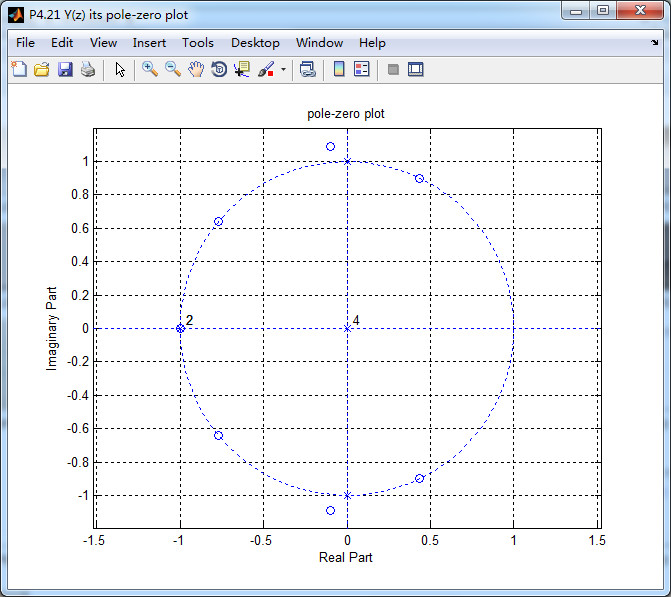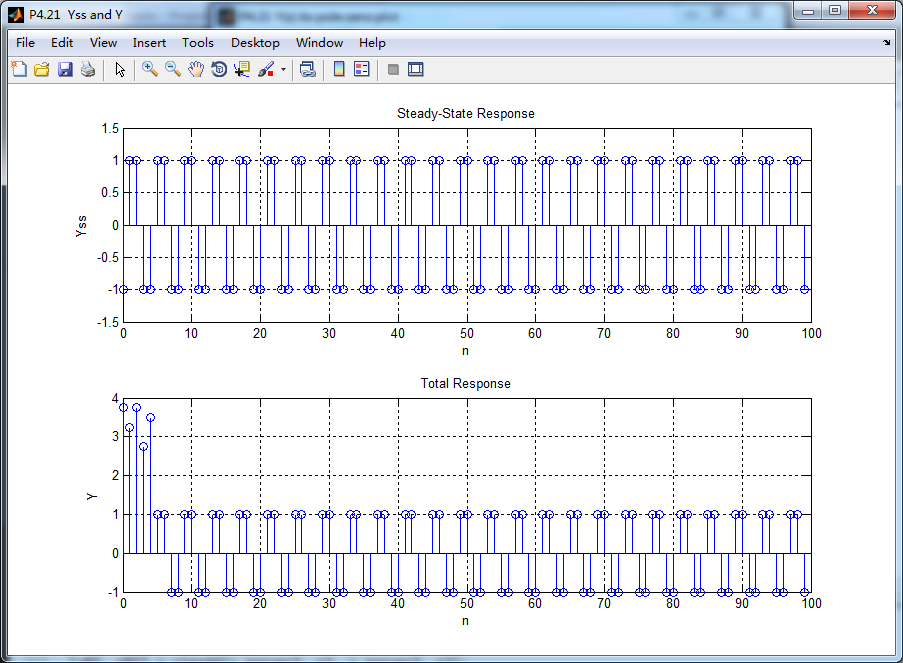快到龙抬头,居然下雪了,天空飘起了雪花,温度下降了近20°。

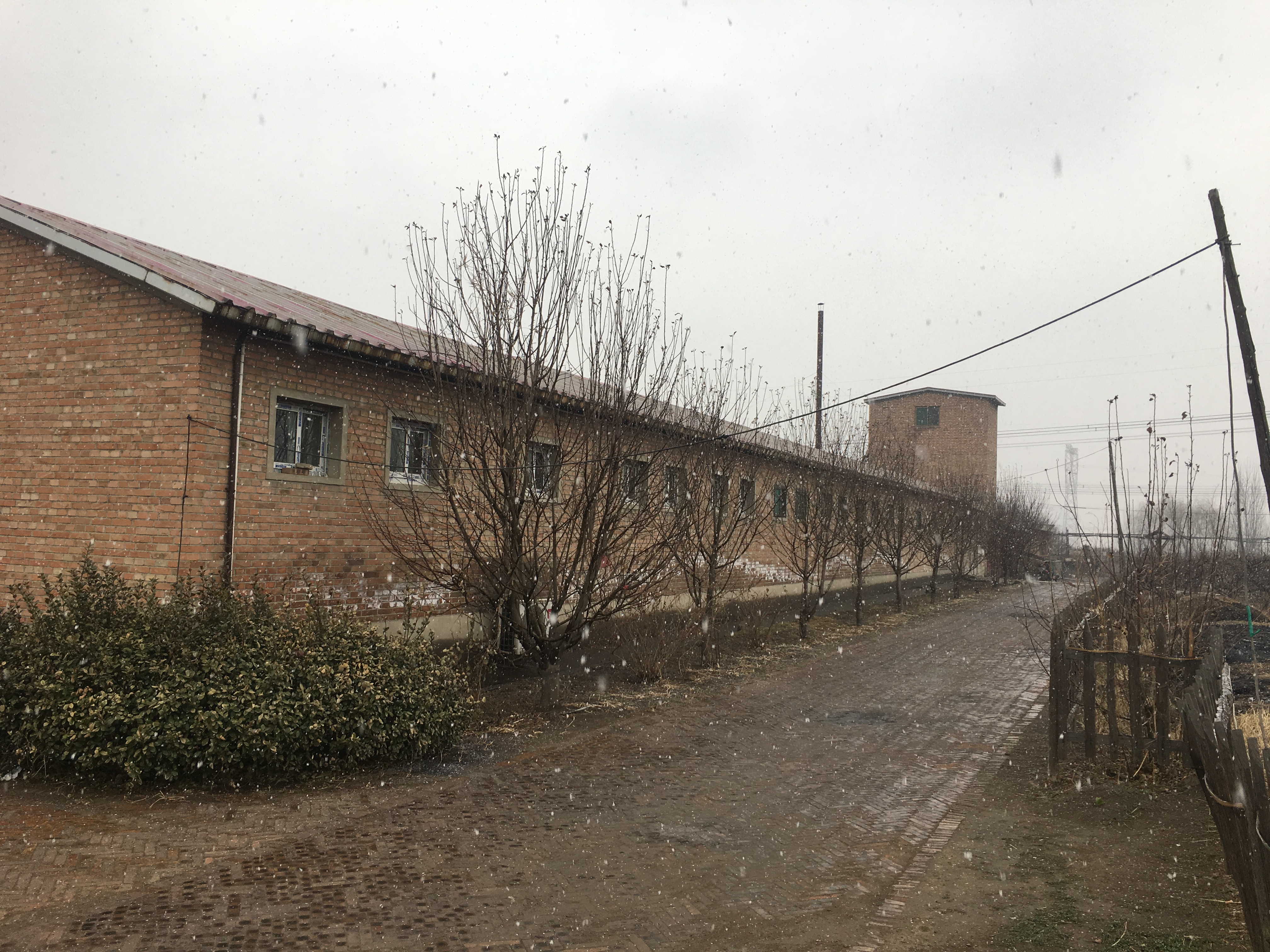



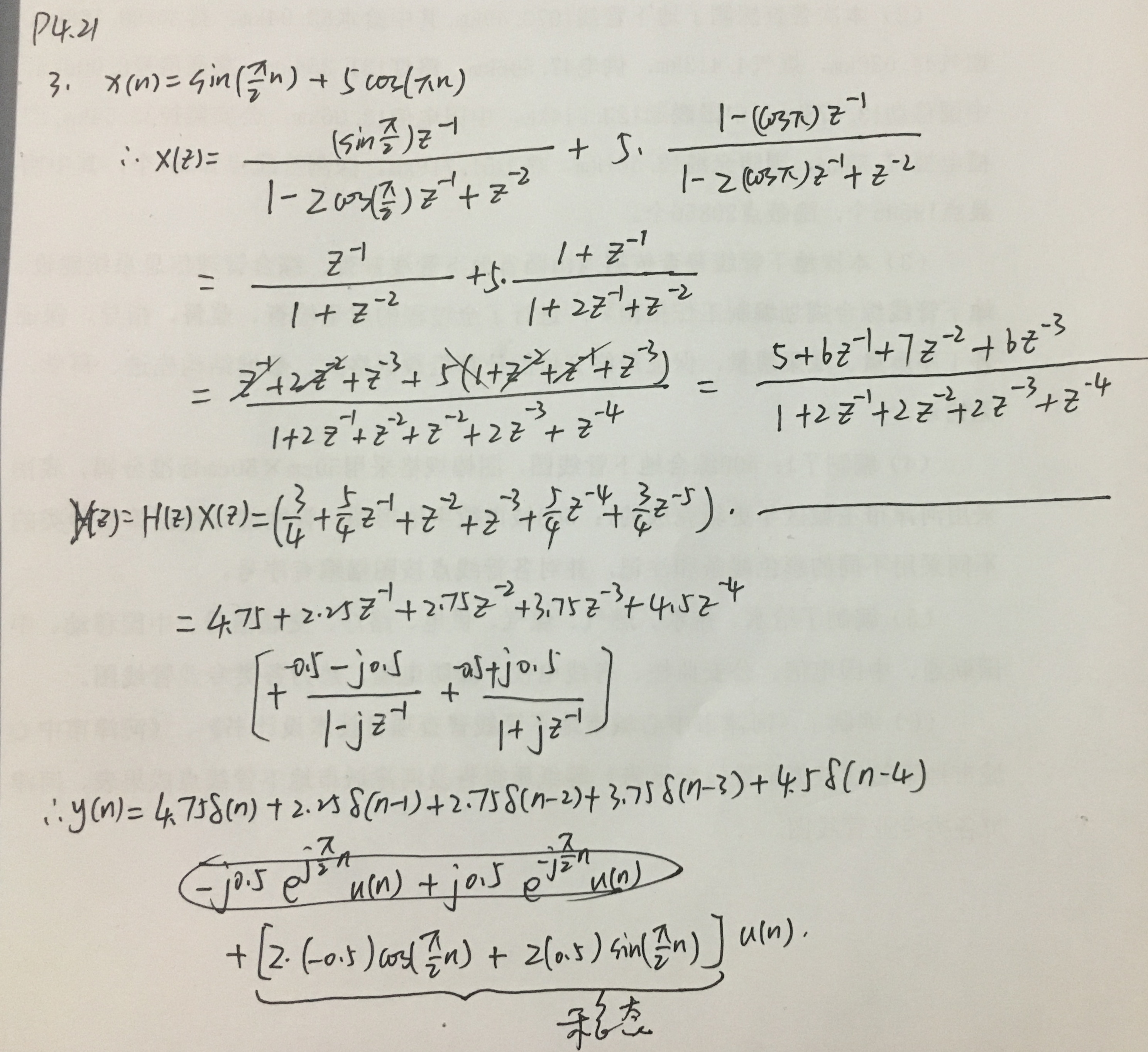
代码:
%% ------------------------------------------------------------------------
%% Output Info about this m-file
fprintf('
***********************************************************
');
fprintf(' <DSP using MATLAB> Problem 4.21
');
banner();
%% ------------------------------------------------------------------------
% ----------------------------------------------------
% 1 H1(z)
% ----------------------------------------------------
b = [3/4, 5/4, 1, 1, 5/4, 3/4]; a = [1]; %
[R, p, C] = residuez(b,a)
Mp = (abs(p))'
Ap = (angle(p))'/pi
%% ------------------------------------------------------
%% START a determine H(z) and sketch
%% ------------------------------------------------------
figure('NumberTitle', 'off', 'Name', 'P4.21 H(z) its pole-zero plot')
set(gcf,'Color','white');
zplane(b,a);
title('pole-zero plot'); grid on;
%% ----------------------------------------------
%% END
%% ----------------------------------------------
% ------------------------------------
% h(n)
% ------------------------------------
[delta, n] = impseq(0, 0, 19);
h_check = filter(b, a, delta); % check sequence
%% --------------------------------------------------------------
%% START b |H| <H
%% 3rd form of freqz
%% --------------------------------------------------------------
w = [-500:1:500]*2*pi/500; H = freqz(b,a,w);
%[H,w] = freqz(b,a,200,'whole'); % 3rd form of freqz
magH = abs(H); angH = angle(H); realH = real(H); imagH = imag(H);
%% ================================================
%% START H's mag ang real imag
%% ================================================
figure('NumberTitle', 'off', 'Name', 'P4.21 DTFT and Real Imaginary Part ');
set(gcf,'Color','white');
subplot(2,2,1); plot(w/pi,magH); grid on; %axis([0,1,0,1.5]);
title('Magnitude Response');
xlabel('frequency in pi units'); ylabel('Magnitude |H|');
subplot(2,2,3); plot(w/pi, angH/pi); grid on; % axis([-1,1,-1,1]);
title('Phase Response');
xlabel('frequency in pi units'); ylabel('Radians/pi');
subplot('2,2,2'); plot(w/pi, realH); grid on;
title('Real Part');
xlabel('frequency in pi units'); ylabel('Real');
subplot('2,2,4'); plot(w/pi, imagH); grid on;
title('Imaginary Part');
xlabel('frequency in pi units'); ylabel('Imaginary');
%% ==================================================
%% END H's mag ang real imag
%% ==================================================
% --------------------------------------------------------------
% x(n) through the filter, we get output y(n)
% --------------------------------------------------------------
N = 200;
nx = [0:1:N-1];
x = sin(pi*nx/2) + 5 * cos(pi*nx);
[y, ny] = conv_m(h_check, n, x, nx);
figure('NumberTitle', 'off', 'Name', 'P4.21 Input & h(n) Sequence');
set(gcf,'Color','white');
subplot(3,1,1); stem(nx, x); grid on; %axis([0,1,0,1.5]);
title('x(n)');
xlabel('n'); ylabel('x');
subplot(3,1,2); stem(n, h_check); grid on; %axis([0,1,0,1.5]);
title('h(n)');
xlabel('n'); ylabel('h');
subplot(3,1,3); stem(ny, y); grid on; %axis([0,1,0,1.5]);
title('y(n)');
xlabel('n'); ylabel('y');
figure('NumberTitle', 'off', 'Name', 'P4.21 Output Sequence');
set(gcf,'Color','white');
subplot(1,1,1); stem(ny, y); grid on; %axis([0,1,0,1.5]);
title('y(n)');
xlabel('n'); ylabel('y');
% ----------------------------------------
% yss Response
% ----------------------------------------
ax = conv([1,0,1], [1,2,1])
bx = conv([0,1], [1,2,1]) + conv([5,5], [1,0,1])
by = conv(bx, b)
ay = ax
zeros = roots(by)
[R, p, C] = residuez(by, ay)
Mp_Y = (abs(p))'
Ap_Y = (angle(p))'/pi
%% ------------------------------------------------------
%% START a determine Y(z) and sketch
%% ------------------------------------------------------
figure('NumberTitle', 'off', 'Name', 'P4.21 Y(z) its pole-zero plot')
set(gcf,'Color','white');
zplane(by, ay);
title('pole-zero plot'); grid on;
% ------------------------------------
% y(n)
% ------------------------------------
LENGH = 100;
[delta, n] = impseq(0, 0, LENGH-1);
y_check = filter(by, ay, delta); % check sequence
y_answer0 = 4.75*delta;
[delta_1, n1] = sigshift(delta, n, 1);
y_answer1 = 2.25*delta_1;
[delta_2, n2] = sigshift(delta, n, 2);
y_answer2 = 2.75*delta_2;
[delta_3, n3] = sigshift(delta, n, 3);
y_answer3 = 3.75*delta_3;
[delta_4, n4] = sigshift(delta, n, 4);
y_answer4 = 4.50*delta_4;
y_answer5 = (2*(-0.5)*cos(pi*n/2) + 2*0.5*sin(pi*n/2) ).*stepseq(0,0,LENGH-1);
[y01, n01] = sigadd(y_answer0, n, y_answer1, n1);
[y02, n02] = sigadd(y_answer2, n2, y_answer3, n3);
[y03, n03] = sigadd(y01, n01, y02, n02);
[y04, n04] = sigadd(y03, n03, y_answer4, n4);
[y_answer, n_answer] = sigadd(y04, n04, y_answer5, n);
figure('NumberTitle', 'off', 'Name', 'P4.21 Yss and Y ');
set(gcf,'Color','white');
subplot(2,1,1); stem(n, y_answer5); grid on; %axis([0,1,0,1.5]);
title('Steady-State Response');
xlabel('n'); ylabel('Yss');
subplot(2,1,2); stem(n, y_check); grid on; % axis([-1,1,-1,1]);
title('Total Response');
xlabel('n'); ylabel('Y');
运行结果:
系统函数H(z)的系数:
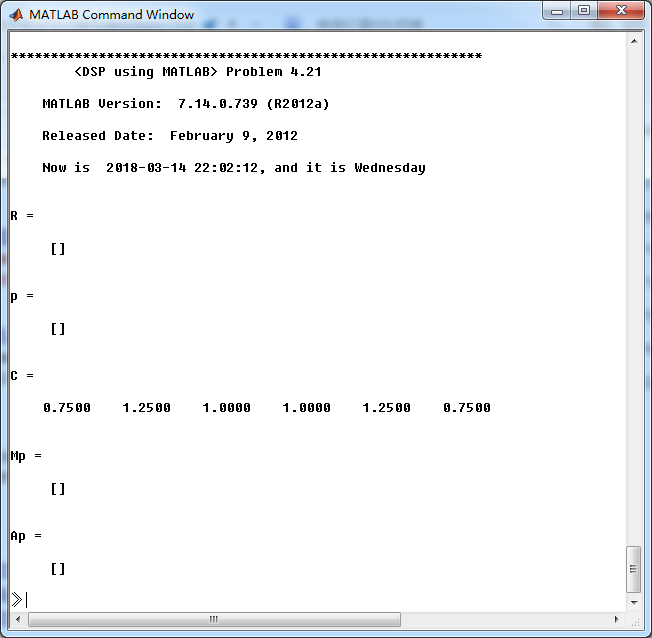
系统的DTFT,注意当ω=π/2和π时的振幅谱、相位谱的值。
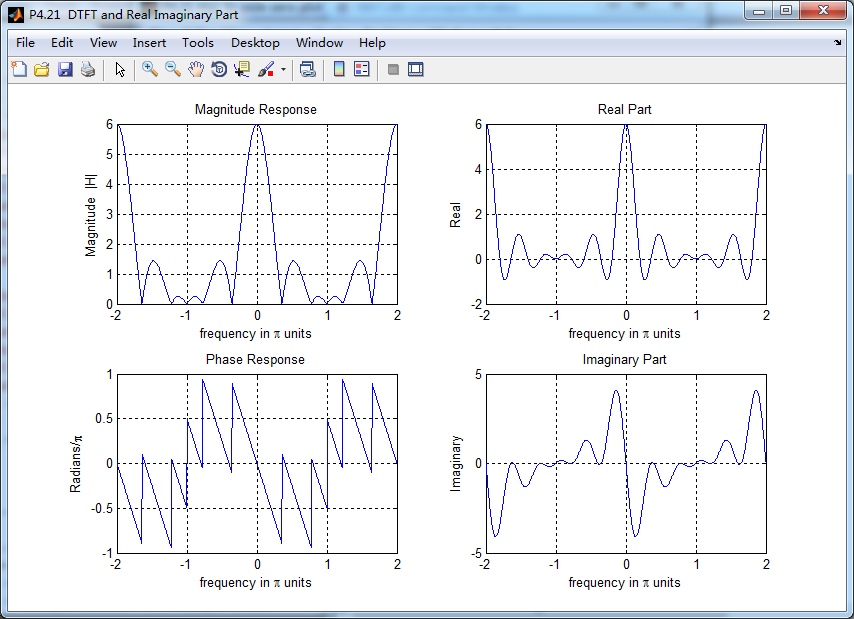
当有输入时,输出的Y(z)进行部分分式展开,留数及对应的极点如下:
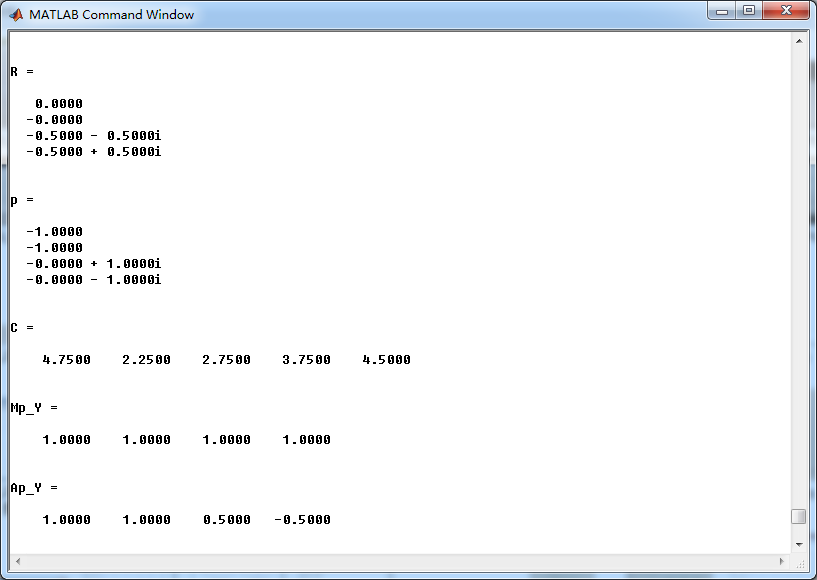
单位圆上z=-1处,极点和零点相互抵消,稳态响应只和正负j有关。
